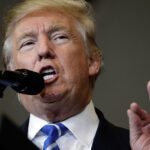The first general election debate between Democrat Hillary Clinton and Republican Donald Trump was held on Monday evening at Hofstra University in New York. NBC News anchor Lester Holt served as the moderator of the event.
Debate Structure
This first debate was organized in a traditional debate style: the two candidates standing behind podiums, facing the audience. All questions were given by the moderator (who was also responsible for creating the questions–which the candidates did not have prior to the start of the debate). Each candidate was given a time limit of two minutes to answer these questions and the candidate who answered first was often given a short amount of time to follow up on their original answer or to respond to the answer given by their opponent. It was the moderator’s job to adhere the candidates to the stated time limits and ensure that the debate kept moving The main categories of questions that Mr. Holt prepared for this debate were: Direction of America, Achieving Prosperity, and Securing America.
Impressions Given by the Candidates
These televised debates can often be an evaluation of the candidate’s personality (and how the candidates respond to one another) as much as it can be about the answers each person provides to the questions. Consider that this is the first time that the two candidates have been on the same stage, facing one another, since the campaigning began over one year ago. Both Trump and Clinton have said many things about one another in various campaign stops for many months. How would it be when they are facing one another in real time?
Winners and Losers
Most after-the-fact analysis given by news reporters and media critics felt that Donald Trump was the “loser” of this first debate. But what does it mean to lose? Both Trump and Clinton had 90 minutes on the major television networks to present themselves to the voting public. They were able to speak about their opponent’s weaknesses and express their own views of how the country should be operated. So, in that sense, both had an excellent opportunity to win voters.
But, televised debates are very much about appearances and comparisons. Many critics felt that Hillary Clinton appeared more prepared, less emotional, more careful in her remarks and in her responses to Trump. In comparison, Donald Trump seemed to provide less detailed answers to questions and frequently interrupted Clinton’s answers to claim that she was wrong about particular statements or accusations.
Next?
The next televised debate is scheduled for Sunday, October 9 at 9 pm. It is structured as a Town Hall debate, where the candidates will not be behind podiums but can walk on the same stage. There will be an audience–who is able to ask some of the questions for the candidates to answer. There will also be some questions that the public can vote on for selection before the daty of the event. You can learn more about the question selection process at this Web site.



